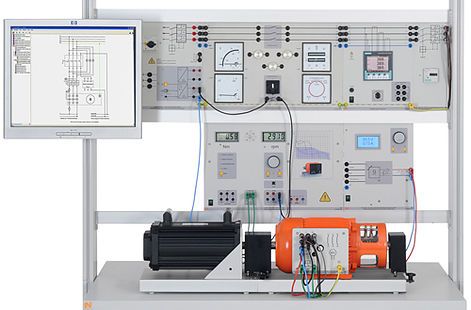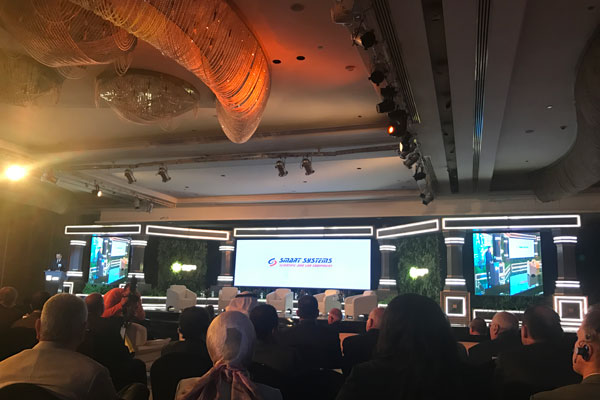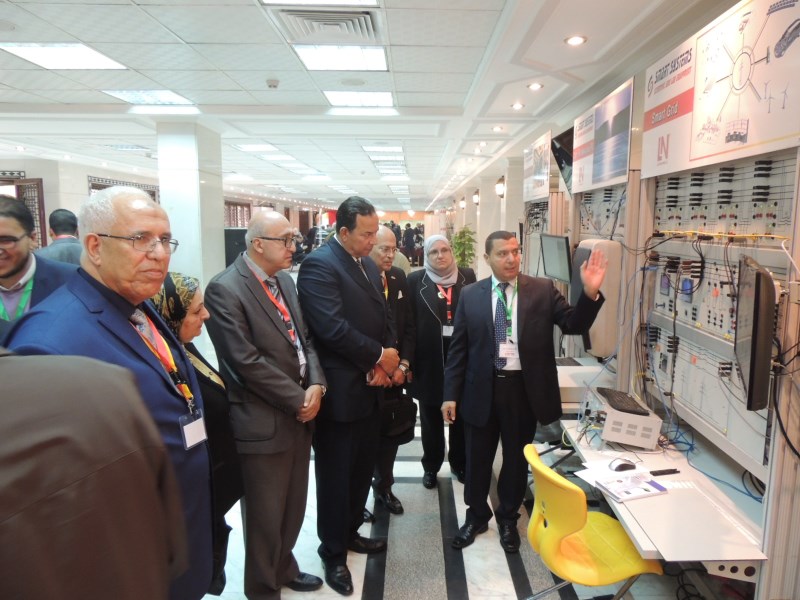EUG Generator control and synchronising circuits


EUG Generator control and synchronising circuits
Electrical power is mainly produced by three-phase generators. This applies to power stations as well as to standby power supplies and wind generators. In addition to the basic experiments dealing with three-phase synchronous generators, the experiments involving the “EUG” module include manual and automatic synchronizing circuits as well as experiments on the automatic power factor control (cos-phi control) and power control. Thus, the ”EUG“ module can be used to simulate power station operation in stand-alone (isolated) or interconnected operation.
EUG 1 Manually operated synchronising circuits
Training contents
“Dark” synchronising circuit
“Light” synchronising circuit
“Cyclic“ synchronising circuit
Active power generation
Inductive reactive power generation
Capacitive reactive power generation
EUG 2 Automatic synchronising circuits, automatic power control and automatic power factor control
Training contents
Automatic synchroniser circuits
Putting into operation and parameterisation of the automation unit
Synchronisation in test mode
Synchronisation to the real power grid
Response of the automation unit to faulty programming
Automatic power factor control
Parameterisation of the automatic cos-phi controller
Synchronisation of the generator to the power grid
Cos-phi control of the synchronous generator
Cos-phi control of the power grid
Automatic power control
Parameterisation of the automatic power controller
Synchronisation of the generator to the power grid
Response of power controller to change in control variable and disturbance variable
Power controller sensitivity and direction of action
EUG Generator control and synchronising circuits
Electrical power is mainly produced by three-phase generators. This applies to power stations as well as to standby power supplies and wind generators. In addition to the basic experiments dealing with three-phase synchronous generators, the experiments involving the “EUG” module include manual and automatic synchronising circuits as well as experiments on the automatic power factor control (cos-phi control) and power control. Thus, the ”EUG“ module can be used to simulate power station operation in stand-alone (isolated) or interconnected operation.
EUG Generator control and synchronising circuits
Electrical power is mainly produced by three-phase generators. This applies to power stations as well as to standby power supplies and wind generators. In addition to the basic experiments dealing with three-phase synchronous generators, the experiments involving the “EUG” module include manual and automatic synchronising circuits as well as experiments on the automatic power factor control (cos-phi control) and power control. Thus, the ”EUG“ module can be used to simulate power station operation in stand-alone (isolated) or interconnected operation. EUG Generator control and synchronising circuits
Electrical power is mainly produced by three-phase generators. This applies to power stations as well as to standby power supplies and wind generators. In addition to the basic experiments dealing with three-phase synchronous generators, the experiments involving the “EUG” module include manual and automatic synchronising circuits as well as experiments on the automatic power factor control (cos-phi control) and power control. Thus, the ”EUG“ module can be used to simulate power station operation in stand-alone (isolated) or interconnected operation. EUG Generator control and synchronising circuits
Electrical power is mainly produced by three-phase generators. This applies to power stations as well as to standby power supplies and wind generators. In addition to the basic experiments dealing with three-phase synchronous generators, the experiments involving the “EUG” module include manual and automatic synchronising circuits as well as experiments on the automatic power factor control (cos-phi control) and power control. Thus, the ”EUG“ module can be used to simulate power station operation in stand-alone (isolated) or interconnected operation. EUG Generator control and synchronising circuits
Electrical power is mainly produced by three-phase generators. This applies to power stations as well as to standby power supplies and wind generators. In addition to the basic experiments dealing with three-phase synchronous generators, the experiments involving the “EUG” module include manual and automatic synchronising circuits as well as experiments on the automatic power factor control (cos-phi control) and power control. Thus, the ”EUG“ module can be used to simulate power station operation in stand-alone (isolated) or interconnected operation.
EUG Generator control and synchronising circuits
Electrical power is mainly produced by three-phase generators. This applies to power stations as well as to standby power supplies and wind generators. In addition to the basic experiments dealing with three-phase synchronous generators, the experiments involving the “EUG” module include manual and automatic synchronising circuits as well as experiments on the automatic power factor control (cos-phi control) and power control. Thus, the ”EUG“ module can be used to simulate power station operation in stand-alone (isolated) or interconnected operation.
EUG Generator control and synchronising circuits
Electrical power is mainly produced by three-phase generators. This applies to power stations as well as to standby power supplies and wind generators. In addition to the basic experiments dealing with three-phase synchronous generators, the experiments involving the “EUG” module include manual and automatic synchronising circuits as well as experiments on the automatic power factor control (cos-phi control) and power control. Thus, the ”EUG“ module can be used to simulate power station operation in stand-alone (isolated) or interconnected operation. EUG Generator control and synchronising circuits
Electrical power is mainly produced by three-phase generators. This applies to power stations as well as to standby power supplies and wind generators. In addition to the basic experiments dealing with three-phase synchronous generators, the experiments involving the “EUG” module include manual and automatic synchronising circuits as well as experiments on the automatic power factor control (cos-phi control) and power control. Thus, the ”EUG“ module can be used to simulate power station operation in stand-alone (isolated) or interconnected operation. EUG Generator control and synchronising circuits
Electrical power is mainly produced by three-phase generators. This applies to power stations as well as to standby power supplies and wind generators. In addition to the basic experiments dealing with three-phase synchronous generators, the experiments involving the “EUG” module include manual and automatic synchronising circuits as well as experiments on the automatic power factor control (cos-phi control) and power control. Thus, the ”EUG“ module can be used to simulate power station operation in stand-alone (isolated) or interconnected operation. EUG Generator control and synchronising circuits
Electrical power is mainly produced by three-phase generators. This applies to power stations as well as to standby power supplies and wind generators. In addition to the basic experiments dealing with three-phase synchronous generators, the experiments involving the “EUG” module include manual and automatic synchronising circuits as well as experiments on the automatic power factor control (cos-phi control) and power control. Thus, the ”EUG“ module can be used to simulate power station operation in stand-alone (isolated) or interconnected operation.


